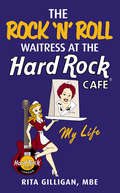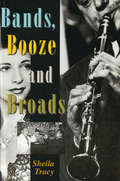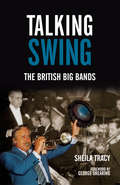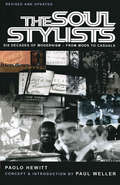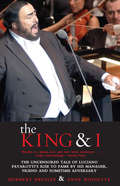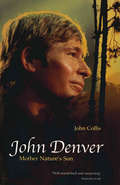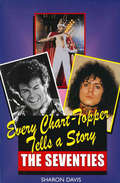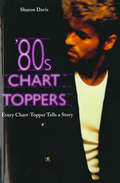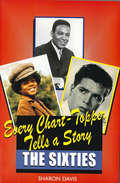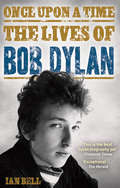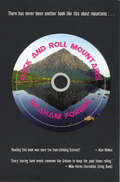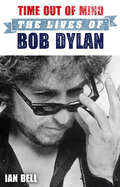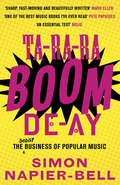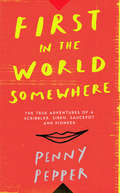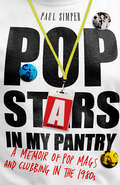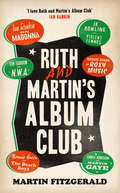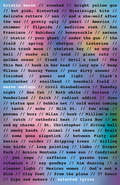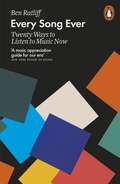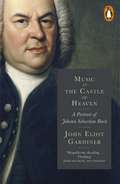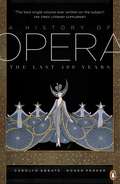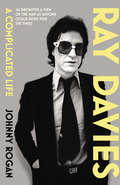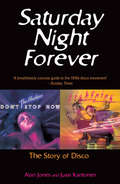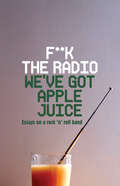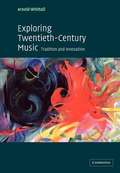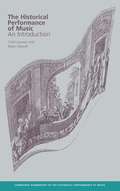- Table View
- List View
The Rock 'N’ Roll Waitress at the Hard Rock Cafe: My Life
by Rita GilliganMeet Rita Gilligan, Hard Rock Cafe’s original ‘Rock ‘n’ Roll’ waitress and international cultural ambassador and MBE. It was 1971 when Hard Rock first opened its doors in London, and Rita was there with her spunky, chatty, and absolutely lovable personality. Over the forty-five years she served at Hard Rock, Rita has collected quite some stories to tell, including her relationship with rock ‘n’ roll celebrities, Hard Rock’s history, and her own personal life struggles. In this book Rita tells her story from being a shy Catholic schoolgirl in Galway to becoming the best known waitress and later ambassador of one of history's most iconic American style restaurants. She also narrates how she met Paul McCartney, Eric Clapton, The Rolling Stones, Bruce Springsteen and many other famous celebrities during her time at the Hard Rock. Written with candid humour and disarming honesty, Rita serves up a brilliantly crafted story about how the Hard Rock, like herself, defied all the odds to become a global phenomenon.
Bands, Booze And Broads
by Sheila TracyIn this captivating study of one of our most popular music genres, Sheila Tracy goes behind the scenes and talks to over 60 Americans who played with the most famous big bands - and who lived to tell the tale. This was no mean feat: swing music''s huge popularity brought the performers wild adulation and, for many, resorting to drugs and alcohol was the only way to keep up. These musicians relate their incredible experiences of life on the road, where the pressure to party every night was enormous.
Talking Swing: The British Big Bands
by Sheila TracyFrom Palace to Palais, the musicians who played in the big bands tell their own stories, bringing to life an unforgettable era.Pre-war reminiscences give an insight into a never-to-be-forgotten era, when London's nightclubs were the haunts of the aristocracy and of royalty, and the Prince of Wales would jump at any opportunity to play drums with the resident band. The elegant world of top hat, white ties and tails has gone for ever, but in Talking Swing the musicians relive those nights when they played for as long as the customers wanted to dance - often into the early hours of the morning. Out of London, there were the variety tours, where the band was top of the bill and there wasn't an empty seat in the house.The problems faced by British musicians during the war years, when London's society bands continued to play throughout the Blitz, were enormous, and they are vividly portrayed in Talking Swing.Amongst those recalled are Ambrose, Jack Hylton, Geraldo, Ted Heath and Syd Lawrence, who took over when almost everyone else had packed it in and who kept on swinging against all odds. This was the golden age of the big bands, and the story of those days is told by the men and women who made the music.
The Soul Stylists: Six Decades of Modernism - From Mods to Casuals
by Paolo HewittThe Soul Stylists is about six decades of Modernism and a highly influential world of clothes and music, but one deliberately hidden away for years from the mainstream media. This book explores the enduring relationship that exists between American black music and British working-class style, tracing a Mod tradition that began in Soho just after the Second World War and continues to this day. From Mod to Casual, from Skinhead to Northern Souler, the soul stylists are an amazing family joined together by a tradition of secrecy, exclusivity and absolute indifference towards the outside world. They pass unnoticed because soul stylists always shun the spotlight. To them, attention to detail is far more important than attention seeking. And here in this book, for the very first time, are some of their stories.
The King and I: The Uncensored Tale of Luciano Pavarotti's Rise to Fame by his Manager, Friend and Sometime Adversary
by Anne Midgette Herbert BreslinIn 1967, Luciano Pavarotti was an up-and-coming young tenor with a voice far more impressive than his stage technique or presence. So Decca, his record company, told him, 'Luciano, you're a real nice guy. So you need a real bastard to do your publicity.' Enter Herbert Breslin. The two of them hit it off and thus began a professional association and a friendship that lasted over 36 years.The King and I is the story of that relationship, during which Breslin guided what he calls, justifiably, 'the greatest career in classical music', moving Pavarotti out of the opera house and into the arms of the mass public. He and Pavarotti changed the landscape of opera and Breslin relates the story of their journey in a candid, witty fashion that is often hysterically frank and profane. His portrait of his friend and client is full of hilarious details that could only come from a true insider. The King and I is the ultimate backstage book about the greatest opera star of the past century - and the last word comes from none other than Luciano Pavarotti himself.
John Denver: Mother Nature's Son
by John CollisJohn Denver was America's biggest-selling solo star of the '70s. In commercial terms he was on a par with Sinatra in the '40s, Elvis in the '50s and the Beatles in the '60s. He experimented with a variety of styles and won fans from such diverse worlds as folk, pop and country music. Beneath the often tranquil surface of his music and his clear, clean tenor voice, however, lurked a darker side to Denver's character. The writer of 'Annie's Song', one of the most straightforward and personal expressions of love, became a wife-beater. The man who cavorted with the Muppets was an alcoholic. The committed environmentalist had his own plane, the most polluting form of transport. John Collis has delved deep to discover exactly who John Denver was. By unravelling the complexities of the singer's personality and background, he reveals Denver as a complicated, contradictory man, much more intriguing than the sometimes placid surface of his music might suggest. Millions of people around the globe found something in his music that touched their souls; Collis, by charting Denver's career and development as an artist, explores his legendary contribution not only to the world of music but also to the society of which he was a protagonist and a victim.
Every Chart Topper Tells a Story: The Seventies
by Sharon DavisThe seventies witnessed great changes not only in dress style but also in music. The psychedelia of the late sixties had mutated into glam rock by the early seventies, while the latter half of the decade is best remembered for the punk and disco explosions which gripped both Britain and America. The number-one singles of the decade are recalled in Every Chart Topper Tells a Story: The Seventies, from artists as diverse as Gary Glitter, David Bowie, Jimi Hendrix, Diana Ross, The Bee Gees, T-Rex, Commodores, Donny Osmond, The Three Degrees and Abba. It is the ideal volume both for those wanting a trip down memory lane and for serious music connoisseurs.
80s Chart-Toppers: Every Chart-Topper Tells a Story
by Sharon DavisThe '80s were a decade of musical change. As the '70s disco stranglehold was broken, rock, gay, dance and pop music competed with funk and soul, romantic ballads and political protest, computerised music and controversy. The glamour of costume, greasepaint and cross-dressing was put to good use by New Romantic groups like Spandau Ballet, Duran Duran, Soft Cell, Culture Club and the Human League, while the world also looked to Britain for the most exciting pop acts such as the multi-million-selling Wham!, Frankie Goes To Hollywood, Eurythmics and the Pet Shop Boys. Mainstream dance music was at its peak, spearheaded by Stock, Aitken and Waterman, and their stable of artists, including Kylie Minogue, Jason Donovan and Rick Astley, were all chart-topping names. From the USA came the artist of the decade, Michael Jackson, while Madonna and Whitney Houston provided the 'Girl Power' of the '80s. The decade also saw the philanthropic side of the music industry as the stars responded to famine in Ethiopia with the charity records 'Do They Know It's Christmas?' and 'We Are The World'. The'80s catered for all musical tastes, no matter how bizarre, and was far more eclectic than any other decade. From bubble-gum pop with Bucks Fizz to the stadium rock of Simple Minds,'80s Chart-Toppers brings a comprehensive year-by-year, month-by-month guide to the hottest sounds of the decade.
Every Chart Topper Tells a Story: The Sixties
by Sharon DavisThe glorious sixties were a decade for the young and rebellious, of cultural freedom and of sexual liberation. The British music scene had never been so adventurous, taking even the American charts by storm.Every Chart-Topper Tells a Story: The Sixties takes a look at the number-one hit singles of the decade in Britain from artists such as The Rolling Stones, The Beatles, Elvis Presley, Dusty Springfield, Ken Dodd, Cilla Black, The Supremes, Cliff Richard and Helen Shapiro, and is a valuable and entertaining source of information for all those interested in the sixties' music scene.
Once Upon a Time: The Lives of Bob Dylan
by Ian BellHalf a century ago a youth appeared from the American hinterland and began a cultural revolution. The world is still coming to terms with what he did. How he did it - and why - has never been fully explored.In Once Upon a Time, award-winning writer Ian Bell draws together the tangled strands of the many lives of Bob Dylan in all their contradictory brilliance. For the first time, the laureate of modern America is set in his entire context: musical, historical, literary, political and personal.In this acclaimed book, full of new insights into the legendary singer, his songs, his life and his era, the artist who invented himself in order to reinvent America is uncovered. Once Upon a Time is a biographical study of a personality that has splintered and reformed, time after time, in a country forever struggling to understand itself. Dylan has become the puzzle that illuminates. Here, in the first part of a major two-volume work, the puzzle is explained.
Rock and Roll Mountains
by Graham Forbes AuthorGraham Forbes loved to play guitar, whether it was with local rock groups pillaging village halls or on the big stages of the world with the Incredible String Band. But, like so many others, he enjoyed the gigs, groupies and booze too much. At 27, he found himself back in Glasgow, ears ringing, scratching his head, completely unemployable, with an empty bottle of tequila in one hand and a huge tax demand in the other. It had been great while it lasted but the party was over.Realising his mind was like and out-of-control firework display and that his next stop was the Happy Duck Rest Home for the Bewildered, Graham noticed there were hills nearby and decided to go for a walk. Just as it seemed he might at last settle down to some sort of normal life he met a crazy climber with a taste for the bizarre . . . It was the beginning of a journey that would transform Graham completely, taking him from poverty to bluffing his way onto the board of directors of a national company, hoping that their next meeting wouldn't be in a hotel he'd wrecked in his previous life. Roaring along with bawdy tales of marauding bands, mad mountaineers and unforgettable Glasgow street characters, Rock and Roll Mountains weaves through wild rock tours and terrifying ice climbing to glowing sunsets on some of the most beautiful summits in the world. It is a book about extreme sport, fear and survival - but without the the gung-ho heroics of mountaineering writers.At times deeply moving, insightful yet hilarious and with an extraordinary climax, this book is for anyone who has looked in the mirror and wondered where it all went wrong . . . Above all, it is very, very funny.
Time Out of Mind: The Lives of Bob Dylan
by Ian BellBy the middle of the 1970s, Bob Dylan’s position as the pre-eminent artist of his generation was assured. The 1975 album Blood on the Tracks seemed to prove, finally, that an uncertain age had found its poet.Perverse or driven, Dylan refused the role. By the decade’s end, the counter-culture’s poster child had embraced conservative, evangelical Christianity. Fans and critics alike were confused; many were aghast. Still the hits kept coming.Then Dylan faltered. His instincts, formerly unerring, deserted him. In the 1980s, what had once appeared unthinkable came to pass: the ‘voice of a generation’ began to sound irrelevant, a tale told to grandchildren.Yet in the autumn of 1997 something remarkable happened. Having failed to release a single new song in seven long years, Dylan put out the equivalent of two albums in a single package. He called it Time Out of Mind. So began the renaissance, artistic and personal, that culminated in 2012’s acclaimed Tempest.In the concluding volume of his groundbreaking study, Ian Bell explores the unparalleled second act in a quintessentially American career. It is a tale of redemption, of an act of creative will against the odds, and of a writer who refused to fade away.Time Out of Mind is the story of the latest, perhaps the last, of the many Bob Dylans. This one might yet turn out to have been the most important of them all.
Ta-Ra-Ra-Boom-De-Ay: The dodgy business of popular music
by Simon Napier-BellLet legendary rock manager Simon Napier-Bell take you inside the (dodgy) world of popular music – not just a creative industry, but a business that has made people rich beyond their wildest dreams.He balances seductive anecdotes – pulling back the curtain on the gritty and absurd side of the industry – with an insightful exploration of the relationship between creativity and money. This book describes the evolution of the industry from 1713 – the year parliament granted writers ownership over what they wrote – to today, when a global, 100 billion pound industry is controlled by just three major players: Sony, Universal and Warner. Inside you will uncover some little-known facts about the industry, including:How a formula for writing hit songs in the 1900s helped create 50,000 of the best-known songs of all time.How infighting in the American pre-war music industry shut down traditional radio and created an opening for country music, race records and rock'n'roll.How Jewish immigrants and black jazz musicians dancing cheek-to-cheek created a template for all popular music that followed.How rock tours became the biggest, quickest, sleaziest and most profitable ventures the music industry has ever seen.After reading Ta-Ra-Ra-Boom-De-Ay, you'll never listen to music in the same way again.
First in the World Somewhere: The True Adventures of a Scribbler, Siren, Saucepot and Pioneer
by Penny PepperPenny Pepper has led an extraordinary life. She is a writer. Poet. Punk. Pioneer. Activist. And she also happens to be disabled. In her absorbing memoir, which spans the mid-1980s up until the millennium, Penny paints a picture of life, love, sex, music, success, failure and misadventures in the UK punk scene of the late 20th century. Craving freedom from the poor Chiltern Hill council estate where she grew up, Penny dreams of moving to London, of writing, of finding her way in the North London music scene. She doesn’t have what others take for granted; she is disabled. And she sets out with just her raw, burgeoning talent to fight the social demons of indifference, discrimination and out-right bigotry… all while wearing micro-mini leather bondage skirts, fishnets and hair extensions.There are parties; there’s sex; there’s music. She exchanges letters with Morrissey. Ken Livingstone helps her find a wheelchair-accessible flat. Her demo tape is reviewed in the NME and played on the radio. Her 90s album Spiral Sky is No. 1 in Greece for a week. And there is opportunity – opportunity to join the radical beginnings of the disability rights movement. First in the World Somewhere tells of her endless adventures. Through the years, there’s an overload of adventure, despair and joy. Often faced with prejudice, she fails, she suffers, she survives and she even sometimes succeeds. Penny does not deny her disability; rather she keeps it at the forefront of everything she stands for, and she tells her story with blood, heart and an undeniable wit.
Pop Stars in My Pantry: A Memoir of Pop Mags and Clubbing in the 1980s
by Paul SimperCorrupted by Spandau. Slated by Boy George. Mothered by Sade. Evicted by Bananarama. Jilted by Madonna.Author, columnist and TV writer Paul Simper had a front-row seat at one of pop stardom’s most exciting shows: the 1980s. His memoir, Pop Stars in My Pantry, is an account of a wide-eyed, wet-behind-the-ears lad from Wiltshire landing in London just as the capital’s club scene went into orbit. As a pop writer and fellow clubber, he had unique access to the artists who would become the biggest pop acts of the decade.On any given day, he might be required to fly a reader to the other side of the world to hang out with Spandau Ballet, accompany Bananarama’s Keren and Wham!’s George Michael on a blind date, help Frankie Goes to Hollywood chuck furniture out of TV studio windows in Rome, watch Boy George styling and flirting with Paul Weller in fake furs, or walk off into the sunset with a newbie called Madonna. It is also the tale of his own attempts at pop stardom with the help of former ’Nana Miss Jacqueline O’Sullivan and an unexpected bonus career as a showbiz party DJ for the likes of Prince, Whitney, Elton and even Al Pacino.This is an endlessly entertaining, behind-the-scenes ride – the ultimate back-stage pass – for 1980s pop enthusiasts and lovers of Smash Hits… from the man who saw it all.
Ruth and Martin’s Album Club: The True Adventures Of A Scribbler, Siren, Saucepot And Pioneer
by Martin FitzgeraldThe concept behind the Ruth and Martin’s Album Club blog is simple: Make people listen to a classic album they’ve never heard before. Make them listen to it two more times. Get them to explain why they never bothered with it before. Then ask them to review it.What began as a simple whim quickly grew in popularity, and now Ruth and Martin’s Album Club has featured some remarkable guests: Ian Rankin on Madonna’s Madonna. Chris Addison on Marvin Gaye’s What’s Going On. Brian Koppelman on The Smiths’ Meat is Murder. JK Rowling on the Violent Femmes’ Violent Femmes. Bonnie Greer on The Beach Boys’ Pet Sounds. Martin Carr on Paul McCartney’s Ram. Brian Bilston on Neil Young’s Harvest. Anita Rani on The Strokes’ Is This It. Richard Osman on Roxy Music’s For Your Pleasure. And many, many more.Each entry features an introduction to each album by blog creator Martin Fitzgerald. What follows are delightful, humorous and insightful contributions from each guest as they have an album forced upon them and – for better or worse – they discover some of the world’s favourite music. Ruth and Martin’s Album Club is a compilation of some of the blog’s greatest hits as well as some exclusive material that has never appeared anywhere before. Throughout, we get an insight into why some people opt out of some music, and what happens when you force them to opt in.
Nerve Endings: Selected Lyrics
by Kristin HershSince forming the seminal art rock band Throwing Muses while still in her teens, Kristin Hersh has been at the forefront of alternative music, acclaimed for her raw, visceral and poetic songwriting.Here, collected for the first time, are the lyrics to one hundred songs, curated by the woman who wrote them. From Throwing Muses classics like ‘Bright Yellow Gun’ to solo material such as ‘Your Ghost’ and her songs with 50 Foot Wave, Nerve Endings encapsulates one of the most fascinating and honest careers in modern rock music.
Every Song Ever: Twenty Ways to Listen to Music Now
by Ben RatliffFrom one of America's celebrated critics, the definitive field guide to listening to music in the age of the CloudThe most significant revolution in the recent history of music has to do with listening: it is now possible to listen to nearly anything at any time, to ignore albums, and to instantly flit across genres and generations, from 1980s Detroit techno to 1890s Viennese neo-romanticism. Yet music criticism has historically focused on the musician's intent, not the listener's experience. Every Song Ever is therefore the definitive field guide to listening in an age of glorious, overwhelming abundance. By revealing the essential similarities between wildly different kinds of music, Ben Ratliff shows how we listen to music now, and suggests how we can listen better.
Music in the Castle of Heaven: A Portrait of Johann Sebastian Bach
by John Eliot GardinerJohann Sebastian Bach is one of the most unfathomable composers in the history of music. How can such sublime work have been produced by a man who (when we can discern his personality at all) seems so ordinary, so opaque - and occasionally so intemperate?John Eliot Gardiner grew up passing one of the only two authentic portraits of Bach every morning and evening on the stairs of his parents' house, where it hung for safety during the Second World War. He has been studying and performing Bach ever since, and is now regarded as one of the composer's greatest living interpreters. The fruits of this lifetime's immersion are distilled in this remarkable book, grounded in the most recent Bach scholarship but moving far beyond it, which explains in wonderful detail the ideas on which Bach drew, how he worked, how his music is constructed, how it achieves its effects - and what it can tell us about Bach the man.Gardiner's background as a historian has encouraged him to search for ways in which scholarship and performance can cooperate and fruitfully coalesce. This has entailed piecing together the few biographical shards, scrutinising the music, and watching for those instances when Bach's personality seems to penetrate the fabric of his notation. Gardiner's aim is 'to give the reader a sense of inhabiting the same experiences and sensations that Bach might have had in the act of music-making. This, I try to show, can help us arrive at a more human likeness discernible in the closely related processes of composing and performing his music.'It is very rare that such an accomplished performer of music should also be a considerable writer and thinker about it. John Eliot Gardiner takes us as deeply into Bach's works and mind as perhaps words can. The result is a unique book about one of the greatest of all creative artists.SIR JOHN ELIOT GARDINER is one of the world's leading conductors, not only of Baroque music but across the whole repertoire. He founded the Monteverdi Choir and Orchestra, the Orchestre de l'Opéra de Lyon, the English Baroque Soloists, and the Orchestre Revolutionnaire et Romantique. He has conducted most of the world's great orchestras and in many of the leading opera houses. He lives and farms in Dorset.
A History of Opera: The Last Four Hundred Years
by Carolyn Abbate Roger ParkerOpera is in many ways the most extraordinary artistic medium of the last four hundred years. Prohibitively expensive and patently unrealistic, it can nevertheless paint the human passions with astonishing power and drama. This book, the first new, full-length, single-volume history of opera for more than a generation provokes in-depth discussions of many works by the greatest opera composers, from Monteverdi, Handel and Mozart, to Verdi and Wagner, to Strauss, Puccini, Berg, and Britten. There are lively discussions of opera's social, political and literary background, its economic cicumstances and the almost continual polemics that have accompanied its development through the centuries. Central to the book is an exploration of the tensions that have always sustained and enlivened opera. Abbate and Parker examine the problems that opera has faced in the last half century, when new works - which were once opera's life-blood - have shrunk to a tiny minority, have largely failed to find a permanent place in the repertoire. Yet the book's final message is one of celebration. Even if the majority of opera's most popular and enduring works were written in what is now a remote European past, in circumstances very different from our own, and the viability of contemporary opera is ever more in question, opera as an art form remains extraordinarily buoyant and challenging. It continues to transform people physically, emotionally, and intellectually, and to articulate human experience in ways no other art form can match.
Ray Davies: A Complicated Life
by Johnny RoganNOW UPDATED WITH A NEW EPILOGUE In the summer of 1964, aged twenty, Ray Davies led the Kinks to fame with their number one hit ‘You Really Got Me’. Within months, they were established among the pop elite, swamped by fans and fast becoming renowned for the rioting at their gigs. But Ray’s journey from working-class Muswell Hill to the Rock ’n’ Roll Hall of Fame was tumultuous in the extreme, featuring breakdowns, bitter lawsuits, spectacular punch-ups and a ban from entering the USA. His relationship with his brother Dave is surely the most ferocious and abusive in music history. Based on countless interviews conducted over several decades, this richly detailed and revelatory biography presents the most frank and intimate portrait yet of Ray Davies.
Saturday Night Forever: The Story of Disco
by Alan Jones Jussi KantonenIf all disco means to you is records like 'I Will Survive' and 'YMCA', tacky fashions and glitter eyeshadow, this book will be a real revelation. For Alan Jones and Jussi Kantonen, disco was an essential soundtrack to their lives. They loved its total hedonistic excess, its drive, its punch and its sweet, catchy melodies. For every chart hit that pounded into the public's consciousness, countless other better tracks were causing hair-raising highs on dance floors where Alan and Jussi and thousands of aficionados like them were strutting their funky stuff.Disco started in obscure underground clubs as a glamour-filled reaction to the plodding, self-indulgent rock music of the late '60s and really took off in the excitement-parched early '70s. Created by people marginalised by their colour (black), race (Latino), sexuality (gay) or class (working), the music and its attendant lifestyle inevitably became watered down and distorted once it slipped from the control of small independent labels and became a worldwide craze. The massive popularity of films such as Saturday Night Fever and the accompanying Bee Gees soundtrack led people to believe that this was disco. But the authors, by exploring such diverse strands as Eurodisco and roller disco, gay disco, and disco fashions, drugs and clubs, show this to be untrue, and instead uncover the magical, multi-layered genre in all its shining, strobe-lit glory. They believe in mirror balls.
F**k The Radio, We've Got Apple Juice: Essays on a Rock 'n' Roll Band
by Miranda WardWhat happens when getting played on Radio 1 isn't the goal anymore? What if music is really just about music?A few years ago, Little Fish were signed to a major label and recorded an album in LA. They've toured with some big names (last year Debbie Harry saw them supporting Courtney Love and asked them to join Blondie for a UK tour, for instance) and played all over the world.But earlier this year, they did the opposite of what the traditional rock n' roll myth says you should do: they came home again. They left their label, set up a recording studio in an Oxford bungalow, and started doing the things that made them happy, instead of the things they thought they should do to get played on Radio 1. They sent hand-letter-pressed cards to their fans, held raffles in the middle of their gigs, and played acoustic sets at local open mic nights.Independence has raised a lot of questions for Little Fish. Why do we make music? What do people want from bands? How do you create a community? How can we make a living? What is a living? Joined by friend and writer Miranda Ward, who quit her job to follow them on their adventure, they plan to explore these questions, even if they never find answers, and to tell the stories about being in a band that you don't get to hear in NME.F**k the Radio is a book about Little Fish, but it's also a book about making it work, making your own way, and making stuff - music, comics, t-shirts, fishy paper squares, stickers, badges, vinyl, stop-motion animations, even books. And fresh apple juice. It's about declaring your independence and rewriting the myths you live by.
Exploring Twentieth-century Music: Tradition And Innovation (PDF)
by Arnold WhittallIn this wide-ranging book, Arnold Whittall considers a group of important composers of the twentieth century, including Debussy, Webern, Schoenberg, Stravinsky, Bartók, Janácek, Britten, Carter, Birtwistle, Andriessen and Adams. He moves skilfully between the cultural and the technical, the general and the particular, to explore the various contexts and critical perspectives which illuminate certain works by these composers. Considering the extent to which place and nationality contribute to the definition of musical character, he investigates the relevance of such images as mirroring and symmetry, the function of genre and the way types of identity may be suggested by such labels as classical, modernist, secular, sacred radical, traditional. These categories are considered as flexible and interactive and they generate a wide-ranging series of narratives delineating some of the most fundamental forces which affected composers and their works within the complex and challenging world of the twentieth century.
The Historical Performance Of Music: An Introduction (Cambridge Handbooks To The Historical Performance Of Music Ser. (PDF))
by Colin J. Lawson Robin StowellOffering students and performers a concise overview of historical performance, this 1999 book takes into account the many significant developments in the discipline. It addresses practical matters rather than philosophical issues and guides readers towards further investigation and interpretation of the evidence provided, not only in the various early instrumental and vocal treatises, but also in examples from the mainstream repertory. Designed as a parent volume for the series Cambridge Handbooks to the Historical Performance of Music, this book provides an historical basis for artistic decision-making which has as its goal the re-creation of performances as close as possible to the composer's original conception. It relates many of the issues discussed to major works by Bach, Mozart, Berlioz and Brahms, composed c.1700–c.1900, the core period which forms the principal (though not exclusive) focus for the whole series.
